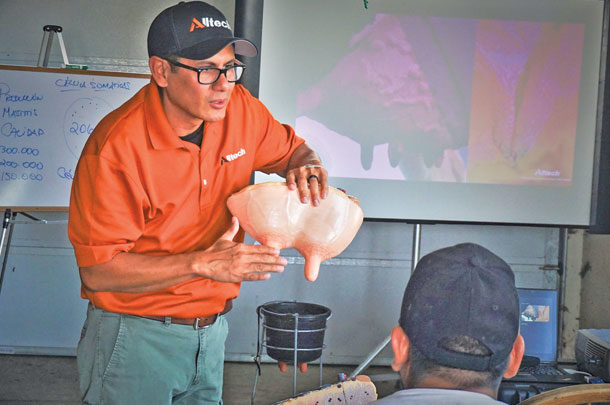Many dairy producers and industry representatives understand that sharing standard operating procedures (SOPs) with workers, including family members and other employees, is critical to profitability.
Unfortunately, some dairy operations may not get the message across to their audience due to the lack of accessibility, understanding and preparation for proper training. I would like to share my experience and a few suggestions I have found successful for creating an effective training environment.
Physical environment
Many dairy facilities are built with the animals in mind but fail to consider the people working with the animals. Do they have access to training or an area where they can focus on learning about strategies, concepts and proper practices for the dairy?
Creating an area or environment that can be utilized for training and learning could be beneficial, especially when external advisers visit the dairy for meetings, training sessions and presentations, and for everyone to feel appreciated, comfortable and motivated.
The way the training area is set up is reflective of the environment you want to create. Provide adequate space and number of chairs. Make sure workers can hear those speaking clearly and comfortably. Have a wall area dedicated to important messages, emergency protocols and phone numbers, as well as a space for training manuals, guides and other materials that can contribute to their duties and continual learning.
Once that area is established, consider how you will work with your team. Whether it be your family members or other employees, you should think about how to deliver your message and instructions clearly, and how to use your body language and tone of voice as well as visual tools to create an open conversation.
4 W’s of an effective training environment
There are four W’s to address when creating an effective training environment.
1. When
Communicate in advance the date and time the training will take place. Use a formal and structured approach. That could include a face-to-face conversation with employees for smaller and family-run dairies – or if you have many employees, use managers to relay messages to the rest of the employees. A printed memo or sign posted in a common area accessible to everyone, a phone call or text message and/or an electronic calendar invitation are also ways to get the message to all employees.
It’s very important to be formal when planning the training environment. There have been occasions when I have been invited to conduct an on-farm training only to find out many of the workers were not aware of the meeting due to the lack of communication or a difference in expectations between managers and employees.
Ensure that you have enough time to prepare an effective training, with content suitable for your audience, and allot adequate time to cover the presentation and respond to questions.
Remember, this is your opportunity to improve efficiency and communication among your employees, so invest the time. This might also help your dairy be more competitive when it comes to employee retention.
2. Where
The area or room where you are going to train your employees will have a significant impact on the training session. It should support the learning objectives and the amount of participation. When choosing or establishing an area to host training sessions, think about the following:
- Size: Can the area accommodate the number of participants with enough chairs and tables, and still provide room for interaction? Barrels or buckets should not be considered “chairs” in an effective training environment. Also consider health and safety protocols in accordance with local, state or national advisories and/or bylaws, such as physical distancing, using personal protective equipment (PPE) and sanitizers.
- Distractions: Select a room free of distractions and noise. If you can’t avoid this, try to host the meetings when there is a quieter time and noises are not present or are minimal.
- Accessible: If you are using a computer, a television and/or a projector, make sure the room has an electrical outlet and access to Wi-Fi or a hotspot if the internet is required.
- Obstructions: When presenting, make sure you are not obstructing the participants’ view; keep eye contact with everybody. Move around the room to engage and encourage participation without intimidation.
- Lighting: If the room has windows and you are planning to use a projector, make sure you are able to control the light and draw the blinds or shades, or use black plastic garbage bags to cover the windows.
- Cleanliness: In most situations, training takes place in the break rooms, so you’ll want to ensure the area is clean and set up for a productive training environment. It will show employees this is a serious meeting and/or training, and that you care about them and they are important in achieving the objectives you are trying to accomplish with the training.
- Incentives: Consider offering light snacks, such as individual packages of potato chips or cookies; and beverages, such as coffee and water; or bring in a meal. You could organize a contest or drawing to encourage participation, especially if partnering with a third party for training, as they may donate a prize. You’ll want to include an area or table dedicated for the food and/or prizes.
3. What
It is important to communicate the type of training that is expected. Think about what resources are required and what kind of training tools you will need.
I am bilingual in English and Spanish, so I will conduct trainings in Spanish if that is the primary language of the dairy workers. I have a PowerPoint presentation designed for each one of my training modules, in English and Spanish. These presentations are built with dairy workers in mind, using lots of pictures and animation while trying to avoid complicated language or graphs that are hard to understand. It’s important to stick to the basics and use visuals to explain the “why” and “how” of the topic being addressed. Incorporating videos in presentations are useful demonstration tools and tend to attract and retain the attention of the audience, if they are short and concise.
Depending on what you are trying to explain, use educational toys such as anatomical models, dairy tools, lab tools, science toys and customized tools to explain best practices and/or correct procedures during your training. For example, I use a bacteria toy and a white blood cell toy to explain what a somatic cell is when discussing milk quality and udder health to milking technicians during my trainings.
4. Who
The person who is facilitating the training is the key in developing an effective training environment. They need to know their audience, be relatable, have the knowledge to explain the topic and answer questions and encourage discussion. Qualities of a good trainer include:
- Listening skills: A good trainer is able to pause and listen closely and respectfully to what workers are saying. This will help them to understand, create a relationship and open the lines of communication between the trainer and the employee.
- Asking the right questions: The trainer must understand the objectives of the dairy and owner and/or manager to determine the training required for employees. To understand this, the trainer needs to ask the right questions before, during and after the training session. A good and effective trainer starts every session explaining the expectations of the training, inviting the audience to have open communication in a safe environment.
- Engaging the learner: The desired outcome of a training session is that employees will absorb and retain the information presented. A good trainer has the confidence to encourage participants to get involved and be active in the learning process.
Remember to be organized, have a plan and stick to it by avoiding conversations outside of the topic being addressed during the training session. Well-organized lessons and materials help focus on the topic. This prevents facilitated sessions from dragging on and losing the audience’s attention.
Finally, a good trainer is continually developing their skills and utilizing industry education resources. They solicit feedback as an opportunity to re-examine their training methods and materials.
Education is the best legacy you can give and leave to your dairy.







